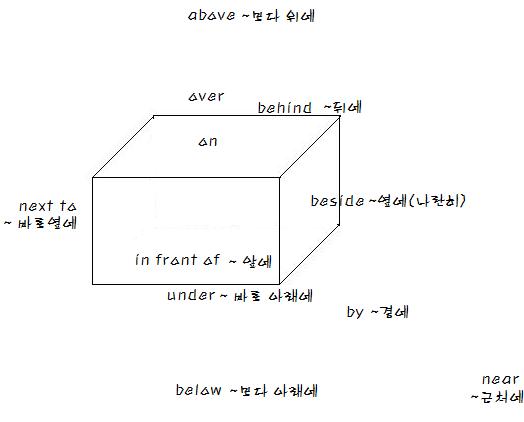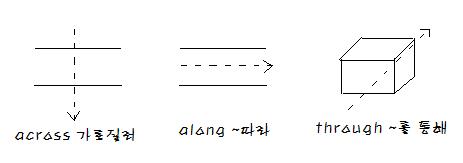전치사의 종류와 다양한 의미
전치사들은 쓰임이 다양하고, 같은 의미더라도 상황에 따라 다양한 전치사가 쓰이는 경우가 많습니다.
또 같은 전치사더라도 다른 어구 한두개가 붙어있는 차이에 따라 의미가 확연히 달라지기도 합니다.
따라서, 모든 경우를 외우려기 보다는 대략적인 몇개를 알아두고 의미를 연장하여 독해하는 것이 좋겠습니다.
(필자는 이걸 읽는 분들이 전치사가 쓰이는 다양한 문장들을 접하면서 실제적 쓰임에 익숙해지기를 권합니다)
1. 전치사의 종류별 의미 정리
①at : 《방향, 장소, 시간, 조건, 상태》등에 점(point)을 하나 콕 찍는듯한 느낌.
* 장소의 의미에서 번지, 소속 학교는 at, 동네이름은 in, 거리이름은 on 을 쓴다.
His brother is a student at[in, of] Yale. (장소, 소속학교)
He lives at 24 Westway. (번지)
The concert starts at[from] 7:30. (구체적인 시점)
She shot at the bird, but missed it. (방향)
②by : 《위치 : ~가까이에》, 《수단이나 근거, 기준》
by +시점 : 완료의 시한 ( ~까지는 해야한다.)
until +시점 : 계속되는 동작/상태의 종지점 ( ~까지줄곧)
We went by the church. (~가까이에)
He entered by the back door. (~를 통해)
Don't judge a man by his clothes. ( ~ 로)
They are paid by the week. (~마다 [단위])
I know him by name, but not by sight (~으로[수단])
The bullet missed him by two inches.(~차이로[정도])
③from :《 출처(출신), 원인, 재료, 근거, 분리 》
~로부터, ~에서(부터), ~와 떨어져
* be made from : ~로부터 만들어지다. (결과물에 재료의 원형이 남지 않음)
be made of : ~로 구성되다. (결과물에 가서도 재료의 원형이 그대로 있음)
Where are the guys from? (출신)
Flour is made from wheat. (재료)
He died from a loss of blood. (원인)
Judging from what I heard, he is a man of high birth. (근거)
The old lady is never free from pain. (분리)
Wine is made from grapes. (재료 - from)
Triangle is made of 3 lines. (재료 - of)
④of : 《출처, 분리, 재료》: from과 거의 같은 의미들
《사물의 소유격》, 《~에 대해, ~한다는 점에서》
He is born of a wealthy family. (출신)
He died of a fever. (원인)
Our house is within three miles of the city. (분리)
The handle of this pot is broken. (사물의 소유격)
I've never heard of such places. (~에 대해)
He never speaks of his dead daughter. (~에 대해)
⑤in : 《시간적. 공간적 내부》 ~ 안에
《비유적 내부》 ~업종에 종사, ~한 상태로, ~형상으로
in +시간의 길이 : 지금부터 ~후에
in +기간 : 기간동안(=during)
I arrive in Berlin on Sunday. (장소)
That woman in white is a nurse. (흰 옷 속의 여자)
It happened in our absence. (=during)
It will be ready in a week. (after not more than)
He is in building. (건설업에 종사)
( *He is in the building. 과 다르다 ! (유의) )
Put your room in order. (~한 상태로)
Sit in a circle around the fire. (~ 형상으로)
⑥to : 《방향, 지점, 정도 등의 목표(target)》 ~에, ~를 향해(~방향으로), ~(에 이르기)까지
The hill is to the west of the city. (~방향으로)
The total came to $50. (~까지)
He brought it to a stop. (~까지)
It is rotten to the core. (~까지)
It's five minutes to seven. (~까지)
Apply some medicine to his wound. (~에)
⑦with : 《동행(소속), 수단, 이유, 동시성》 ~와(함께), ~로, ~로 인해, ~함에따라
with + all 양보형 구문, with +명 + 보어 동시상황
I took my children with me. (동행)
She is a flight attendant with KAL. (소속)
What did you cut it with? (수단)
She is in bed with a fever. (이유)
With the development of science, (~함에따라)
They stood there with their hats off. (동시상황)
⑧for:《목적,방향,가치》~을 위하여,~을 향하여,~에 대하여
What are you doing that for? (목적)
He is the right man for the job. (가치)
The ship is bound for Pusan. (방향)
I paid $350 for the digital camera. (가치)
He looks young for his age. (~에 비해(대하여))
He blamed me for the delay. ( 이유 )
* for? during? through? (세가지 모두 『~동안』. 그러나....)
- for + 《기간의 길이》 뒤에는 지속기간에 대응하여, a few minutes, two hours, a long time 등
『불특정기간』을 나타내는 말이 온다.
He has lived in Seoul for one year.
We stayed there (for) two weeks.
- during +《특정의 기간》 뒤에는 발생시기에 대응하여, the summer, the night, that season 등의
『특정기간』을 나타내는 말이나, my stay in Seoul, the crisis, his absence 등의
『특정 기간의 행위/상태』를 나타내는 말이 온다.
I'm always at home during the afternoon.
Mary slept during the lecture.
- through +《특정의 기간》 ~동안 내내
⑨on : 넓고 평평한《공간적. 기간적》표면에 점하나 찍는 느낌.
또는, 《지탱, 근거, 수단》의미로 쓰이기도 한다.
* 느낌이 잘 살아있는 숙어 : put on, depend on.
Can you see that fly on the ceiling?(공간적 표면)
He put a ring on her finger. (공간적 표면)
The store is on the 43rd street. (공간적 표면)
on Sunday we stayed at home. (시간적 표면)
The earth turns on its axis. ( 의존 )
Cattle live on grass. ( 의존 )
I heard it on the radio. ( 수단 )
2. 의미 범주별 의미 정리
1) 시간을 나타내는 전치사들
- at : at ten o'clock, at noon (시점)
- on : on Sunday, on the morning of May 5
특정한 날의 아침/오후/저녁 을 말하거나 수식어가 붙을 때
- in : in 2005(2500년에), in 2 hours. (2시간 지나자마자)
( * 기간의 이름이 오느냐, 기간의 길이가 오느냐에 따라 )
- after : after you come in. after 2 hours.
~뒤에, ~후에 : 너가 들어온 뒤에, 2시간 후에
- within (시간) : ~이내에
- since (시간을 나타내는 어구) : ~ 이래로 (지금까지)
- from ( 시간을 나타내는 어구 ) : ~부터(시작점만 의미)
2) 위치를 나타내는 전치사들
- at : at the corner. (비교적 좁은 장소)
- in : in a small village. in Korea
(지방/대륙/나라 등의 넓은 공간적 개념에서) ~안에
- on : on the equater, on the road ( ~ 위의)
* on은 아래의 두 개념과 달리 접하고 있는 상태
- above/below : ~보다 위에 / ~ 보다 아래에
( 위나 아래로 한참 떨어져 있는 개념)
- over/under : ~의 바로 위에/ ~의 바로 아래에
( 위나 아래로 가까이 떨어져 있는 개념)
- by : by the window ~ 가까이에'
- beside : beside the river ~의 곁(옆)에 (나란히)
- near : (by보다 거리가 먼 장소/시간적 개념) ~ 가까이
* We live by the sea. (바다가 보일 정도의 거리)
We live near the sea. (10~20km 정도로, 심리적으로
는 가까울지나, 물리적으로는 다소 떨어진 거리.)
- between : ( 하나하나의 위치가 명확히 구분되는 둘 이 상의 사물/사람들에 대해 ) ~ 사이에(서), ~ 중에서
- among : ( 하나하나가 명확히 구분되지 않는 셋 이상의 사물/사람의 집합체에 대해 ) ~ 사이에(서), ~ 중에서
- in front of ( in the front of ) : (구체적인 장소) ~앞에
- behind ( in the back of ) : (구체적인 장소) ~ 뒤에
- before : (다소 비구체적인 장소) ~ 쯤의 앞에

3) 그 외 주요 전치사들
- but : (소극적으로) ~를 포함시키지 않고. ~ 빼고.
do anything but, do nothing but ~
Everybody is here but Sujin.
- except : (적극적으로) ~을 제외하고. ~ 빼고.
He works everyday except Sunday.
- across : ~를 건너, 횡단하여, 가로질러
We moved across the country. (대륙을 가로질러)
- along : ~와 나란히, 평행하게
I walked along the road. (길따라 걸었다)
- through : ~를 거쳐, ~를 통과하여
He drived through the tollgate.

- about : ~에 관하여, ~에 대하여
Nobody know about it.
* 이보다 더 구체적일 경우에는 on 을 쓴다.
출처-영잘원
'영문법' 카테고리의 다른 글
| 영어 콤마 사용법~ (0) | 2010.07.16 |
|---|---|
| 명사 (0) | 2010.07.12 |
| 영어발음의 변화 규칙 (0) | 2010.07.11 |
| should 와 must 의 차이점~ (0) | 2010.04.30 |
| 제5강- 시제- 현재/과거/미래/완료 (0) | 2010.03.29 |